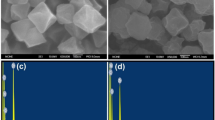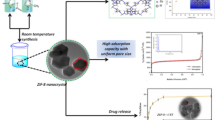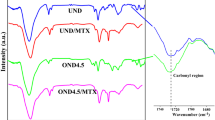Abstract
A low cytotoxic metal–organic framework (MOF) UiO-66 (UiO stands for University of Oslo) and NH2-UiO-66, that showed high cell viability of HFF-2 via 3-(4, 5-dimethylthiazol-2-yl) 2, 5-diphenyl tetrazolium assay, was reported as an effective adsorbent (antidotal) agents. The structure of MOFs was confirmed by Fourier transform infrared, Field emission scanning electron microscopy (FESEM) and X-ray diffraction. Thermal behavior of MOFs was investigated using with thermogravimetric analyzer in nitrogen atmosphere to check the thermal stability. FESEM showed NH2-UiO-66 displayed symmetrical crystals with triangular base pyramid morphology, with the particle size around 100 nm and uniform size distribution. The specific surface areas were calculated using the Brunauer–Emmett–Teller method and surface area and total pore volume of NH2-UiO-66 were calculated to be 1258 m2/g and 0.51 cm3/g, respectively. Methotrexate salt (MTX) was selected as the model drug which was adsorbed into inner pores and channels of MOFs by diffusion manner. The interaction between MOFs and MTX and the effect of pH on interaction between them in aqueous solution was investigated. The final results showed that UiO-66 have high adsorbing capacity and great affinity to MTX.










Similar content being viewed by others
References
R.A. Rudd, Increases in drug and opioid-involved overdose deaths—United States, 2010–2015. MMWR 65, 50–51 (2016)
J. Mounteney et al., The drug situation in Europe: an overview of data available on illicit drugs and new psychoactive substances from European monitoring in 2015. Addiction 111(1), 34–48 (2016)
L.M. Meyer et al., Treatment of acute leukemia with amethopterin (4-amino, 10-methyl pteroyl glutamic acid). Acta Haematol. 4(3), 157–167 (1950)
B.F. Hoskins, R. Robson, Infinite polymeric frameworks consisting of three dimensionally linked rod-like segments. J. Am. Chem. Soc. 111(15), 5962–5964 (1989)
T. Yamada et al., Proton-conductive metal–organic frameworks. Bull. Chem. Soc. Jpn. 89(1), 1–10 (2015)
Y.-B. Huang et al., Multifunctional metal-organic framework catalysts: synergistic catalysis and tandem reactions. Chem. Soc. Rev. 46, 126–157 (2017)
B. Van de Voorde et al., Adsorptive separation on metal–organic frameworks in the liquid phase. Chem. Soc. Rev. 43(16), 5766–5788 (2014)
Q. Chen et al., Selective adsorption of cationic dyes by UiO-66-NH 2. Appl. Surf. Sci. 327, 77–85 (2015)
C. Wang et al., Applications of water stable metal–organic frameworks. Chem. Soc. Rev. 45(18), 5107–5134 (2016)
N.S. Bobbitt et al., Metal–organic frameworks for the removal of toxic industrial chemicals and chemical warfare agents. Chem. Soc. Rev. (2017). doi:10.1039/c7cs00108h
I. Erucar, S. Keskin, Computational investigation of metal organic frameworks for storage and delivery of anticancer drugs. J. Mater. Chem. B 5(35), 7342–7351 (2017)
J. Liu et al., Controllable porosity conversion of metal-organic frameworks composed of natural ingredients for drug delivery. Chem. Commun. 53(55), 7804–7807 (2017)
T. Sattar, M. Athar, Hydrothermal synthesis and characterization of copper glycinate (Bio-MOF-29) and its in vitro drugs adsorption studies. Op. J. Inorg. Chem. 7(02), 17 (2017)
S.E.H. Etaiw et al., Catalytic, Luminescence Activities and Structure of Metal-Organic Frameworks Containing CuCN Building Blocks and Bipodal Bridging Ligands. J. Inorg. Organomet. Polym. Mater. 21(3), 465–475 (2011)
S. Kitagawa, R. Kitaura, S.i.. Noro, Functional porous coordination polymers. Angew. Chem. Int. Ed. 43(18), 2334–2375 (2004)
M. Eddaoudi et al., Systematic design of pore size and functionality in isoreticular MOFs and their application in methane storage. Science 295(5554), 469–472 (2002)
F. Li et al., Two Metal–organic frameworks with pharmaceutical ingredient linker: influence of pH and temperature. J. Inorg. Organomet. Polym. Mater. 27(1), 334–341 (2017)
A.R. Abbasi et al., Methyl orange removal from wastewater using [Zn2 (oba) 2 (4-bpdh)] 3DMF metal–organic frameworks nanostructures. J. Inorg. Organomet. Polym. Mater. 25(6), 1582–1589 (2015)
N.A. Khan et al., Adsorption and removal of phthalic acid and diethyl phthalate from water with zeolitic imidazolate and metal–organic frameworks. J. Hazard. Mater. 282, 194–200 (2015)
M. Özacar, İ.A. Şengil, Adsorption of acid dyes from aqueous solutions by calcined alunite and granular activated carbon. Adsorption 8(4), 301–308 (2002)
B. Armağan, M. Turan, Equilibrium studies on the adsorption of reactive azo dyes into zeolite. Desalination 170(1), 33–39 (2004)
F. Rozada et al., Dye adsorption by sewage sludge-based activated carbons in batch and fixed-bed systems. Bioresour. Technol. 87(3), 221–230 (2003)
G. Annadurai, R.-S. Juang, D.-J. Lee, Use of cellulose-based wastes for adsorption of dyes from aqueous solutions. J. Hazard. Mater. 92(3), 263–274 (2002)
R. Mostafa Zamani, M. Rostami, M. Aghajanzadeh, H.K. Manjili, K. Rostamizadeh, H. Danafar, Mesoporous titanium dioxide@zinc oxide-graphene oxide nanocarries for colon-specific drug delivery. J. Mater. Sci. (2017). doi:10.1007/s10853-017-1673-6
H. Molavi et al., Enhancing CO2/N2 adsorption selectivity via post-synthetic modification of NH2-UiO-66 (Zr). Microporous Mesoporous Mater. 257, 193–201 (2018)
A. Nematollahzadeh, A. Shojaei, M. Karimi, Chemically modified organic/inorganic nanoporous composite particles for the adsorption of reactive black 5 from aqueous solution. React. Funct. Polym. 86, 7–15 (2015)
M. Karimi, A. Nematollahzadeh, A. Shojaei, Amino functionalized hierarchically produced porous polyacrylamide microspheres for the removal of chromium (VI) from aqueous solution. J. Porous. Mater. (2017). doi:10.1007/s10934-017-0413-2
H. Mahdavi, L. Ahmadian-Alam, H. Molavi, Grafting of sulfonated monomer onto an amino-silane functionalized 2-aminoterephthalate metal—organic framework via surface-initiated redox polymerization: proton-conducting solid electrolytes. Polym. Int. 64(11), 1578–1584 (2015)
H. Nosrati et al., Green and one-pot surface coating of iron oxide magnetic nanoparticles with natural amino acids and biocompatibility investigation. Appl. Organomet. Chem. (2017). doi:10.1002/aoc.4069
H. Kheiri Manjili et al., Pharmacokinetics and in vitro and in vivo delivery of sulforaphane by PCL–PEG–PCL copolymeric-based micelles. Artif. Cells Nanomed. Biotechnol. 22(8), 947–957 (2017)
H. Danafar, Study of the composition of polycaprolactone/poly (ethylene glycol)/polycaprolactone copolymer and drug-to-polymer ratio on drug loading efficiency of curcumin to nanoparticles. Jundishapur J. Nat. Pharm. Prod. (2017). doi:10.5812/jjnpp.34179
A. Nomani et al., Preparation and characterization of copolymeric polymersomes for protein delivery. Drug Res. 67(08), 458–465 (2017)
H. Danafar et al., Drug-conjugated PLA–PEG–PLA copolymers: a novel approach for controlled delivery of hydrophilic drugs by micelle formation. Pharm. Dev. Technol. 22(8), 947–957 (2017). doi:10.3109/10837450.2015.1125920
H. Danafar et al., Co-delivery of hydrophilic and hydrophobic drugs by micelles: a new approach using drug conjugated PEG–PCLNanoparticles. Drug Dev. Ind. Pharm. 43(11), 1908–1918 (2017)
A. Sadeghi et al., Synthesis, characterization, and antibacterial effects of trimethylated and triethylated 6-NH2-6-deoxy chitosan. J. Bioact. Compat. Polym. 23(3), 262–275 (2008)
H. Li et al., Design and synthesis of an exceptionally stable and highly porous metal-organic framework. Nature 402(6759), 276 (1999)
J.H. Cavka et al., A new zirconium inorganic building brick forming metal organic frameworks with exceptional stability. J. Am. Chem. Soc. 130(42), 13850–13851 (2008)
H.R. Abid et al., Adsorption of CH4 and CO2 on Zr-metal organic frameworks. J. Colloid. Interface Sci. 366(1), 120–124 (2012)
H. Saleem, U. Rafique, R.P. Davies, Investigations on post-synthetically modified UiO-66-NH2 for the adsorptive removal of heavy metal ions from aqueous solution. Microporous Mesoporous Mater. 221, 238–244 (2016)
H.R. Abid et al., Amino-functionalized Zr-MOF nanoparticles for adsorption of CO2 and CH4. Int. J. Smart Nano Mater. 4(1), 72–82 (2013)
V. Fierro et al., Adsorption of phenol onto activated carbons having different textural and surface properties. Microporous Mesoporous Mater. 111(1), 276–284 (2008)
E. Haque et al., Adsorption of phenol on mesoporous carbon CMK-3: effect of textural properties. Bull. Korean Chem. Soc. 31(6), 1638–1642 (2010)
A. Gundogdu et al., Adsorption of phenol from aqueous solution on a low-cost activated carbon produced from tea industry waste: equilibrium, kinetic, and thermodynamic study. J. Chem. Eng. Data 57(10), 2733–2743 (2012)
J. Hu et al., Removal of chromium from aqueous solution by using oxidized multiwalled carbon nanotubes. J. Hazard. Mater. 162(2), 1542–1550 (2009)
M. Vicente et al., Synthesis, dark toxicity and induction of in vitro DNA photodamage by a tetra (4-nido-carboranylphenyl) porphyrin. J. Photochem. Photobiol. B 68(2), 123–132 (2002)
Acknowledgements
This study was supported financially by Zanjan University of medical science and Sharif University of Technology, Iran.
Author information
Authors and Affiliations
Corresponding authors
Ethics declarations
Conflict of interest
Authors declare no conflict of interest.
Rights and permissions
About this article
Cite this article
Aghajanzadeh, M., Zamani, M., Molavi, H. et al. Preparation of Metal–Organic Frameworks UiO-66 for Adsorptive Removal of Methotrexate from Aqueous Solution. J Inorg Organomet Polym 28, 177–186 (2018). https://doi.org/10.1007/s10904-017-0709-3
Received:
Accepted:
Published:
Issue Date:
DOI: https://doi.org/10.1007/s10904-017-0709-3




